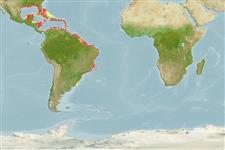Environment: milieu / climate zone / depth range / distribution range
पारिस्थितिकी
समुद्री; स्वच्छ जल, अलवण जल; खारा ड़िमरसल; ऐम्फिढरोमस (Ref. 46888). Tropical; 25°C - 30°C (Ref. 97140); 32°N -
Northwest to western Central Atlantic: Bermuda, Bahamas, South Carolina and northern Gulf of Mexico in USA to southeastern Brazil.
आकार / वज़न / Age
Maturity: Lm ? range ? - ? cm
Max length : 25.0 cm TL पुल्लिंग / अलिंग; (Ref. 7251); common length : 12.5 cm TL पुल्लिंग / अलिंग; (Ref. 12193)
पृष्ठीय रीढ़ (सम्पूर्ण): 7; पृष्ठीय सौफट रेज़ (सम्पूर्ण): 9; गुदा कांटा 0; ऐनल सौफट रेज़: 9
Adults are found on shallow, muddy or sandy bottoms (Ref. 13628). They appear to prefer estuarine freshwater tributaries, occurring in waters with a salinity range of 0 to 19 ppt (Ref. 7251), or up to 36.6 in some cases (Ref. 97140). Feed on dipteran larvae and pupae (especially the juveniles); crustaceans like crabs and shrimps; and small fishes. The diet changes with sexual maturity and season. Gonadal development takes place during the dry season. Average size at maturity is 5.7 mm for males and 4.3 mm for females (Ref. 35237).
Life cycle and mating behavior
परिपक्व अवधि | पुनरुत्पत्ति | मछलीऔ का अंडे देना | अंडे | Fecundity | लार्वा
Robins, C.R. and G.C. Ray, 1986. A field guide to Atlantic coast fishes of North America. Houghton Mifflin Company, Boston, U.S.A. 354 p. (Ref. 7251)
IUCN Red List Status (Ref. 130435)
Threat to humans
Harmless
Human uses
अधिक जानकारी
आम नामउपशब्दचपायचयपरभक्षीईकोटोकसीकोलौजीपुनरुत्पत्तिपरिपक्व अवधिमछलीऔ का अंडे देनाSpawning aggregationFecundityअंडेEgg development
संदर्भजलीयकृषिजलीयकृषि रूपरेखाखींचआनुवंशिकीElectrophoresesहैरेटिबिलटीबीमारीप्रक्रमणNutrientsMass conversion
सहयोगीयोतस्वीरेStamps, Coins Misc.ध्वनिसिगुयटिरारफ्तारतैरने के प्रकारगिल क्षेत्रOtolithsदिमागदृष्टि
साधन
Special reports
Download XML
इंटरनेट स्रोत
Estimates based on models
Preferred temperature (Ref.
123201): 23.4 - 28.1, mean 27.2 °C (based on 808 cells).
Phylogenetic diversity index (Ref.
82804): PD
50 = 0.5000 [Uniqueness, from 0.5 = low to 2.0 = high].
Trophic level (Ref.
69278): 3.7 ±0.4 se; based on diet studies.
लौटाव (Ref.
120179): माध्यम, न्यूनतम जनसंख्या दुगनी होने का समय 1.4 - 4.4 वर्ष। (Preliminary K or Fecundity.).
Fishing Vulnerability (Ref.
59153): Low vulnerability (15 of 100).
